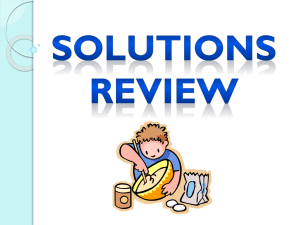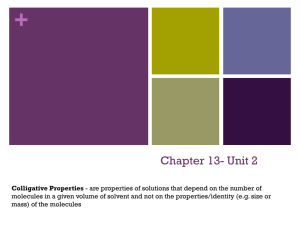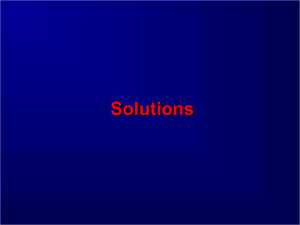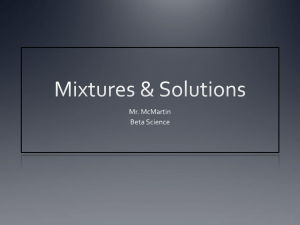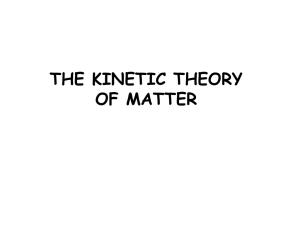Solutions and Solubility
advertisement
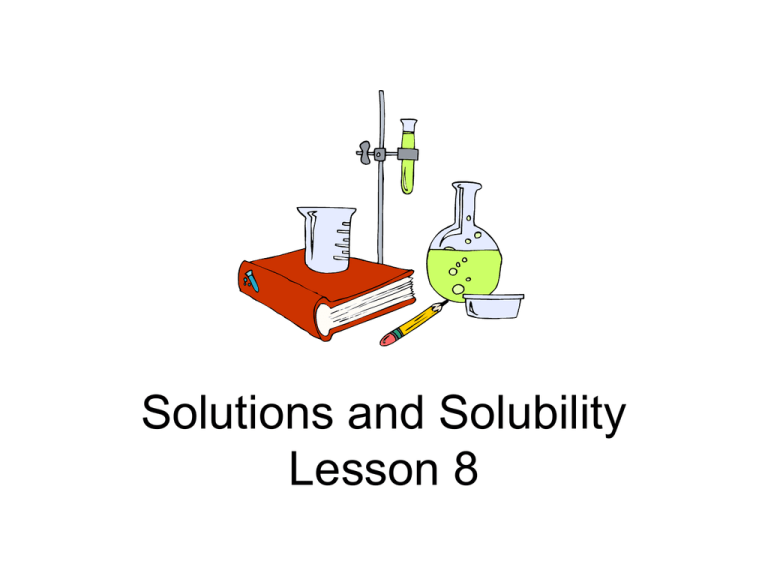
Solutions and Solubility Lesson 8 Vocabulary • Solution: mixture of substances that are evenly spread throughout each other; particles in a solution are molecular in size. • Solvent: part of a solution that is usually present in the larger amount. • Solute: part of a solution that is usually present in the smaller amount. • Dissolves: breaks up into the smallest particles of that substance so that a solution forms. • Dilute: a solution containing a relatively small quantity of solute as compared with the amount of solvent. Solutions • Did you know that water in a lake, river, ocean, rain, fish tanks, pools, etc is not pure? • Even though it looks pure, it is a mixture of materials. • Water becomes a mixture when materials are added to it. Other Examples of Mixtures • • • • Fruit salad Soft drinks Gravel Chex mix Can you think of other examples? Vocabulary • Solution – a homogeneous mixture that looks like a single substance and has the same properties throughout. It is made up of two or more pure substances. Solution • Example: This mixture is made up of water, coffee, cream, hazelnut flavoring, milk, and sugar. Once it is all mixed together, it looks like a single substance. Coffee is an example of a solution. I would like to order a latte with whipped cream, flavor shot of hazelnut, skinny with low fat milk and make it extra hot. The cream, hazelnut, milk, and sugar are called the solute because it is being dissolved into the water. The water is called the solvent because it is doing the dissolving. Soluble Substances • • • • • Salt Sugar Powdered drink mix Baking soda Food coloring Solutions A substance that dissolves in water is said to be soluble. For example, the sugar and cream are said to be soluble in water. A substance that does not dissolve, is said to be insoluble. For example: water and oil do not mix.oilIt is said to be insoluble. water Non-Soluble Substances • • • • • Sand Rocks Paper clips Rubber ball Rice Solutions • A solution consists of a solute dissolved in a solvent. The solute is always in lesser quantity than the solvent. • The solvent does the dissolving and is always in greater quantity than the solute. Solute – green particles Solution Solvent – yellow liquid Properties of Solutions Solutions share certain properties. 1. The particles of solvent and solute in solutions are spread evenly throughout the mixture. 2. The particles of the solute are molecular in size. 3. A solid solute can usually be separated from a liquid solvent by physical means such as evaporation. Lets Experiment! Objective: To observe the dissolving of a solute in a solvent. Materials: clear drinking glass powdered fruit drink flat toothpick Activity from: Chemistry for every kid. Procedure • Fill the clear glass with water. • Select a flavor of powdered fruit drink that has a dark color such as cherry, grape, raspberry, etc. • Use the wide end of a popsicle stick to pick up a scoop of the powdered drink. • Gently shake the powder over the glass of water. • Continue to add the powder until the water becomes completely colored. Results • Streamers of color precipitate down through the water. Precipitate means to fall downward. • The crystals dissolve in the water as they fall. Dissolving means that a substance breaks apart into smaller and smaller particles and spreads out evenly throughout the solvent. The dissolving material, the solute, is the powdered crystals and the solvent is the water. The combination of a solute and a solvent produces a liquid solution. Problem Your grandmother sent you a beautiful ceramic hot chocolate mug for your birthday. The mug was packed in the Styrofoam peanuts (packing material). Unfortunately the peanuts did not protect the mug. How can you separate the Styrofoam peanuts from the ceramic shards?

